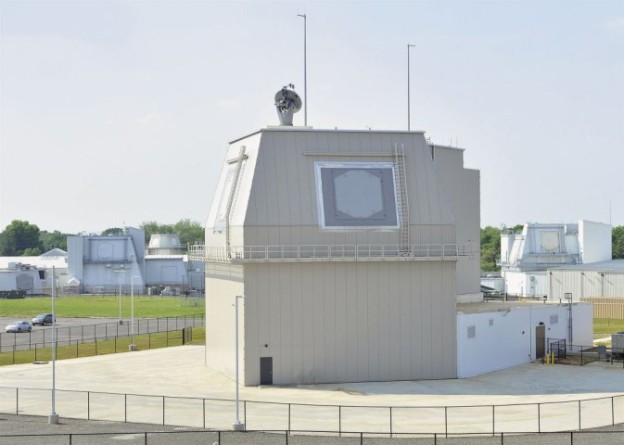
From the outside, the so-called deckhouse of the Aegis Ashore anti-missile system looks nothing like its seagoing counterpart installed on American warships. The multi-story modular building might seem more at home in an industrial park.
Just like the shipboard version, however, the shore-side deckhouse provides the power, space and cooling to accommodate the servers, consoles and pipes needed to operate an SPY-1D(V) Aegis radar system, along with the command-and-control equipment needed to launch interceptors or to dispatch ballistic missiles.
“I’m using the exact same weapon system as a ship,” Navy Capt. Jeff Weston, the Aegis Ashore program manager for the Missile Defense Agency (MDA), said during a visit by USNI News to Lockheed Martin’s Aegis testing facility in Moorestown, N.J., on Tuesday.
The deckhouse is the first of two planned European-based Aegis Ashore batteries. As a cheaper and more politically palatable way for the U.S. to protect European interests and allies, the program employs the same systems used by the U.S.’s Arleigh Burke-class guided missile destroyers (DDG-51).
In 2009, the Obama administration announced a radical shift from the Bush administration’s plan to build 10 missile silos in Poland and construct a massive radar facility in the Czech Republic. Obama shelved the deployment of a two-stage variant of the Ground-Based Interceptor—estimated to cost billions— in favor of the so-called European Phased Adaptive Approach.
The EPAA transferred the ballistic missile defense mission to the Navy’s Aegis BMD destroyers and cruisers in the Mediterranean and to the two planned Eastern Europe Aegis Ashore sites, at $800 million per site. The MDA also contracted to build a third test site at the Pacific Missile Range Facility Barking Sands, Hawaii. In July, MDA and Lockheed Martin completed radar testing in Moorestown and the equipment now will be shipped to Barking Sands for live-fire testing.
The Aegis Ashore program builds on the weapon systems that initially were designed to protect large U.S. naval formations from the threat of enemy aircraft. The 1980s-era system uses a combination of the Lockheed Martin SPY-1 radar and the Raytheon standard missile. The technology evolved—adding computing power and more sophisticated interceptors—to take on a ballistic missile defense role.
Currently the U.S. Navy has slightly more than two dozen Aegis BMD ships.
The sites in Romania and Poland—planned to be operational by 2015 and 2018 respectively—will shed the anti-air warfare (AAW) mission and focus on the BMD role, Weston said.
“This is the Aegis weapon from a ship. It can do AAW, terminal defense and mid-course intercept,” Weston said. “In Romania, we made the decision to field only mid-course intercept. We’re not going to do anti-air warfare in someone else’s country.”
The sites in Poland and Romania will field three, 8-cell Mark-41 Vertical Launch System (VLS) connected to the deckhouse. but future systems could add or subtract missiles.
The deckhouse can be shipped to a new location in standard shipping containers. To carry out the planned moves, Lockheed Martin designed interior components of Aegis Ashore to rest on aluminum skids, making them easy to drop into place on the floor of the building.
The MDA and the Navy originally required that the deckhouse be capable of being relocated within 120 days, but recently dropped the specification for the four-month timetable.
“The genesis of the requirement is, Congress invests hundreds of millions of dollars somewhere into some country and we pull out of that country and we have to leave it behind,” Weston said. “There was an interest in not leaving that investment behind.”
The so-called removable equipment units arrive from Lockheed subcontractors prewired for the Aegis component installation in Moorestown and quickly can be plugged into the weapon system.
Though the components are the same, the Romanian and Polish sites will operate differently from their at-sea counterparts.
“If you’re operating a ship, we would scan the horizon every two seconds looking for sea-skimming missiles,” Weston said. “We’re trained to defend the ship all the time. We’re constantly looking everywhere to see everything. Aegis Ashore is really not radiating, it’s not searching. It’s waiting to be told that a ballistic missile has been launched. You wouldn’t scan everyday looking for ballistic missiles in space. We have all sorts of satellites that would detect a launch. If the radar were just searching, that would be a waste of time.”
The sites will be manned by a three rotating watches of 11 sailors along with a team of civilian technicians to help maintain the Aegis components.
“The rules of war require uniformed service members on the consoles,” Weston said, “but the civilian maintainers can assist in maintaining the systems. That was a conscious decision with the Navy to have a partial military and partial civilian team to man and maintain this thing.”
Currently, MDA’s plan was to field the three planned Aegis Ashore sites. Now that the concept has been proven, MDA has the option to build similar sites.
Removed from the constraints of the complicated math needed to field Aegis at sea, Aegis Ashore can easily slide almost anywhere.
“We designed to system that it could fit on 80 percent of the planet,” Weston said.





